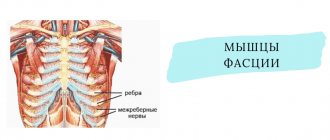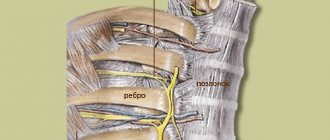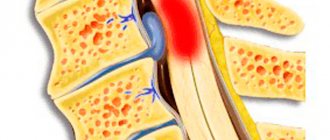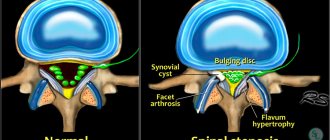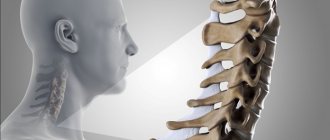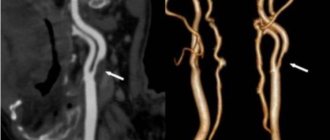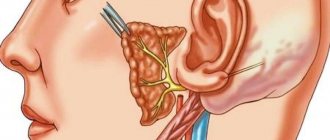What is intercostal neuralgia?
Neuralgia of the intercostal nerves is pain of a different nature that occurs due to various etiological factors. It is more often observed in adult men and women over 30-35 years of age. Symptoms of neuralgia may appear suddenly on one or both sides of the chest, along one or more intercostal nerves. The disease has an ICD code - M.79.2.
To understand what intercostal neuralgia is, you should understand the anatomical features of the thoracic nerves. There are 12 pairs in total. Each intercostal nerve contains motor, sensory and sympathetic fibers. It originates from the anterior roots of the spinal cord of the thoracic spine, passes along the lower edge of each rib, reaching the sternum. The parietal pleura covers the nerve fibers on top.
Thoracic nerves transmit impulses to the skin, the musculo-ligamentous apparatus of the chest and the anterior wall of the abdomen, partly the pleura and peritoneum, and the mammary glands. Sensitive fibers of neighboring nerve trunks actively interact with each other, creating cross innervation.
Drug treatment
The main subgroups of pharmaceutical drugs that help cope with the manifestations of intercostal compression are anti-inflammatory drugs and muscle relaxants. The mechanism of their effect on the pathological focus is based on the ability to quickly reduce swelling in the nerve fiber, as well as increase the space in the pinched area.
If the thoracic spine is affected - intercostal neuralgia, treatment usually begins with the following medications:
- Nise;
- Aertal;
- Movalis;
- Mydocalm;
- Baklosan.
Additionally, specialists prescribe subgroup B vitamins - Milgamma, Neuromultivit, Combilipen. They help improve the conduction of nerve impulses in intercostal tissues and reduce the area of inflammation. Sedatives and analgesics, for example, Paracetamol, restore the patient’s well-being.
Traditional medicine methods successfully complement traditional treatment recipes. Various decoctions and infusions of medicinal plants have an equally strong anti-inflammatory effect. In addition, they have virtually no contraindications or restrictions. However, each of these prescriptions should be agreed with your doctor.
How to distinguish intercostal neuralgia from heart disease?
If neuralgia has acute symptoms in the thoracic region on the left side, differential diagnosis with heart disease must be carried out. You should not look for the cause of the pain syndrome on your own. Thoracalgia on the left side should always be a reason to consult a doctor.
Heart pain and symptoms of intercostal neuralgia on the left have distinctive features:
| Intercostal acute neuralgia on the left: typical symptoms | Cardiovascular diseases: characteristic manifestations |
| The pain intensifies with forced breathing, coughing, sneezing, laughing, physical exertion and movement, but does not change with fast walking and excitement. | The pain does not change its intensity with a deep breath or muscle tension, but intensifies with cardio exercise (fast walking, running, climbing stairs). |
| Chest neuralgia is not relieved by taking nitroglycerin | With angina pectoris, the pain attack goes away within 3-5 minutes after using nitroglycerin. With myocardial infarction, severe pain cannot be relieved with medications. In this case, you should immediately call an ambulance. |
| Normal pulse and blood pressure are determined | Changes in heart rate and blood pressure |
| Pain increases with palpation of the ribs and spaces between them | The intensity of pain does not change when palpating the intercostal spaces |
| Painful symptoms on the left “go” along the nerve or are encircling in nature | Pain is localized behind the sternum or in the projection of the heart |
Symptoms of intercostal neuralgia on the left and right should also be differentiated from other diseases (pleurisy, pneumonia, thoracic aortic aneurysm, pericarditis, acute pancreatitis and others). If there is severe pain in the chest, only a doctor can determine exactly what it is - neuralgia or another pathology.
Symptoms
The main symptom of intercostal neuralgia is pain. It can be burning, aching or stabbing. Painful sensations always manifest themselves in attacks, between which the person’s condition returns to normal. The pain intensifies with any movement, coughing, or deep breathing. Therefore, patients often experience difficulties with respiratory function and try not to move.
With neuralgia, the symptoms affect the thoracic region on the left side, the pain is focal in nature, but can radiate to nearby areas of the body. The sensations tend to be concentrated in the left side of the chest and in the middle of the front, often also appearing on the right or in the sides on both sides. Slightly less often they involve the area of the stomach, armpits, arms, shoulder blades or lumbar region. This is due to the fact that the nerves affected by intercostal neuralgia have a large number of branches connecting them to other parts of the body.
Pain is not the only symptom. Many patients also experience other signs of neuralgia:
- Increased blood pressure;
- Heart rhythm failure;
- Stiffness in the area of the pinched nerve;
- Pallor or redness of the skin;
- Skin rash over a compressed nerve;
- Decreased sensitivity in the affected area;
- Increased sweating;
- Convulsive attacks;
- Dyspnea;
- Severe lacrimation.
In infants, neuralgia is manifested by frequent screams, capriciousness, attempts to change body position, slight muscle twitching, and general pallor. Slightly older children may hold their chest at the site of pain.
An important part of the symptoms of intercostal neuralgia are the features of its manifestation. It is they who make it possible to distinguish this problem from heart diseases, which are often suspected when the listed symptoms are identified.
Features:
- Seizures occur at any time and are not associated with any activities or normal activities.
- The pain lasts from a couple of minutes to several days, and intensifies with any movements that put stress on the chest.
- When pressing on the areas where the pinched nerve passes, the person experiences pain.
- The patient begins to choke, he lacks air, and a feeling of severe stiffness appears inside the chest.
- The attack ends suddenly; no specific conditions are required for this.
If left untreated, unpleasant complications may develop. Almost always, the result of untreated neuralgia is the death of the nerve root, which leads to the disappearance of pain, but causes chronic shortness of breath and heaviness inside the chest.
Causes of intercostal neuralgia and risk factors
Intercostal neuralgia can develop for a variety of reasons. Among them are:
- injuries to the thoracic nerves, chest and spine;
- surgical interventions, long-term immobilization of a person in a certain position;
- poisoning with chemicals, prolonged use of medications;
- congenital developmental anomalies, hereditary diseases;
- infectious processes (shingles, tuberculosis, brucellosis and others);
- some neurological diseases, such as radiculitis and multiple sclerosis;
- diseases of the spine (osteochondrosis, deforming spondylosis, herniated intervertebral discs);
- compression of nerve branches in the bone-connective sheaths, for example, in the presence of scar changes, benign or malignant neoplasms;
- immunodeficiency (HIV infection, cancer, etc.);
- allergic reactions;
- diabetes;
- various metabolic disorders in nervous tissue and its hypoxia;
- lack of B vitamins in the body;
- alcohol abuse;
- osteoporosis;
- pathology of nearby anatomical structures (aorta, lungs, pleura);
- various systemic diseases (atherosclerosis, rheumatism, anemia, thyrotoxicosis, etc.).
More often, chest neuralgia appears due to several causes. Therefore, it is typical for older patients with vascular, degenerative and metabolic disorders. Sometimes symptoms of neuralgia appear after excessive physical activity, sudden movements or prolonged stay in one position. They can also occur after hypothermia or severe stress.
More often, intercostal neuralgia is observed on the left or right; less often, there is a bilateral lesion. In most cases, the pathogenesis is based on muscle spasm, leading to compression of nerve fibers. Pain occurs in response to nerve damage.
In children, signs of intercostal neuralgia are rare. When they appear, parents should definitely show the child to the doctor, as this may be a signal of the presence of a serious pathology. The doctor will determine the possible causes and explain how to cure intercostal neuralgia in this case.
Therapeutic measures
Treatment of the disease is usually carried out in several stages. The first thing the doctor needs to do is eliminate the severe pain syndrome. Only after this can you begin to treat the disease that caused the pinching.
The patient is given strict bed rest for 3–4 days. The surface of the bed must be hard - this is a prerequisite for effective treatment. If necessary, you can place a hard shield under the mattress.
Drug treatment of pathology includes the following drugs:
- painkillers from the NSAID group. These drugs are included in the treatment plan to eliminate pain and relieve inflammation. If the patient experiences very severe pain, then doctors may resort to lidocaine blockade;
- muscle relaxants. These drugs help to quickly eliminate muscle spasms, thereby alleviating the patient’s condition;
- B vitamins. They must be included in the treatment plan, as they have a positive effect on nerve structures;
- sedatives.
It is also important to identify the true cause that provoked the occurrence of neuralgia. If a person has a history of any general disease, then treatment should definitely begin.
In order to restore the anatomical position of the thoracic and cervical spine, the course of treatment must include:
- massage;
- physiotherapy;
- a course of manual therapy;
- acupuncture;
- acupuncture;
- set of exercises;
- laser therapy.
If conservative treatment turns out to be ineffective, then in this case they resort to surgical treatment methods - they eliminate the root causes of the pathology (they treat osteochondrosis, herniated intervertebral discs, etc.).
Forms of the disease
Chest neuralgia can be primary (an independent pathology) and secondary (a symptom of another disease). There are also radicular and reflex forms of the disease. In the first case, symptoms of intercostal neuralgia on the left and right arise due to irritation of the spinal roots. The second type of pathology occurs due to a negative effect on peripheral receptors.
In addition, clinicians distinguish the following types of thoracic neuralgia:
- musculoskeletal;
- vertebrogenic;
- spicy;
- chronic;
- right-sided;
- left-handed;
- psychogenic;
- during pregnancy.
Intercostal neuralgia of a certain type has its own characteristic symptoms and treatment features.
Symptoms of neuralgia on the right and left
Any neuralgia, including intercostal neuralgia, is primarily pain. Painful sensations can be of a different nature (aching, dull, sharp, piercing, burning) and have different intensity. Sometimes the pain is so severe that it forces a person to take a forced position and sharply limit physical activity. Intercostal neuralgia, which has pronounced symptoms, is described by patients as a lumbago or electric current discharge running from the spine to the sternum.
Thoracalgia often begins gradually, with a tingling sensation in the intercostal spaces, then acquires pronounced intensity. Less often it occurs suddenly. The pain can radiate to the scapula, epigastric area, heart, arm and lower back. Sometimes it takes on an encircling character. It intensifies with changes in body position, movements, coughing and deep breathing.
As a rule, painful attacks are constantly repeated, lasting from a few seconds to 2-3 minutes. Therefore, treatment of acute intercostal neuralgia on the right and left, first of all, always begins with the elimination of pain.
In addition to thoracalgia, a person may be bothered by characteristic local signs caused by the influence of sympathetic, sensory and motor nerve fibers. Intercostal neuralgia, depending on the damage to a particular nerve, will have characteristic symptoms on the right, left or both sides of the chest:
- impaired sensitivity, crawling sensation, numbness, tingling;
- muscle twitching;
- increased sweating;
- change in skin color.
If chest neuralgia appears against the background of a herpes infection, it may be accompanied by skin rashes. The latter appear 2-4 days after the onset of thoracalgia. Elements of the rash are located on the skin of the intercostal space in the form of small pink spots, which then turn into vesicles and then into crusts. Subsequently, traces of pigmentation may remain on the skin.
Diagnostics
For an experienced specialist, it is not difficult to diagnose intercostal neuralgia based on characteristic complaints - pain in the intercostal spaces when turning, bending, and also when examining the patient - touching the inflamed tissue increases discomfort.
However, it is imperative to carry out diagnostic procedures in order to exclude the course of other internal diseases in which the clinical manifestations will be similar. Examination of the area of intercostal spaces implies:
- chest x-ray - identification of injuries, cracked ribs, course of degenerative lesions of the vertebrae, curvature of the spine;
- electrocardiogram - to assess the activity of the heart and its parts, the presence of foci of myocardial ischemia;
- a biochemical blood test allows you to timely recognize the course of rheumatoid and gouty processes in the body;
- if oncology is suspected, the specialist will recommend computed tomography or magnetic resonance imaging - the images can more clearly examine the localization of the pathological focus, its size, and the involvement of neighboring structures.
We advise you to study: How to treat back chondrosis
After analyzing all the information from the diagnostic measures, the specialist will decide what to do for neuralgia and how to treat it.
Diagnosis of intercostal neuralgia
Make an appointment Shpigel Anna Yakovlevna Neurologist, massage therapist 33 years of experience. The specialist receives: - newborn children and schoolchildren - adults - athletes Reviews from patients Consultation from 3000 rubles.
Acute intercostal neuralgia is a reason to contact a competent, qualified neurologist. Since symptoms in adults with damage to the thoracic nerves can be disguised as other diseases, the patient must undergo a comprehensive examination to exclude possible pathology. The doctor must conduct a survey and examination.
The person’s posture is noteworthy when he leans towards the healthy side, so as not to provoke a painful attack. Palpation of the chest reveals pain. Trigger points are identified at the lower edge of the rib, where the affected nerve passes. If neuralgia affects several nerve branches, which often happens, this leads to a decrease or complete loss of sensitivity in the corresponding area of the body.
First of all, the doctor must distinguish the symptoms of intercostal neuralgia on the left from cardiovascular pathology. For this purpose, the patient undergoes an ECG. If indicated, a cardiologist is consulted. In order to correctly diagnose and treat intercostal neuralgia, the doctor also excludes diseases of the respiratory system, digestive tract, musculoskeletal system, infectious processes and other diseases. He may prescribe a number of additional tests (laboratory tests, x-ray of the lungs, ultrasound of the abdominal organs, MRI of the spine, etc.).
Thoracic neuralgia is an indication for electroneurography. This method allows you to determine the condition of nerve fibers by assessing their structure and functionality.
Chest neuralgia can be a manifestation of benign and malignant tumors. It is often the first symptom of a herniated disc and degenerative changes in the spine. Therefore, early identification of its causes is considered an important task for the neurologist and the patient.
Causes of the disease
Before starting to treat thoracic neuralgia, the doctor determines the possible causes of the development of the pathology. Damage to the thoracic nerves most often occurs against the background of the following unfavorable factors:
- hypothermia of the body;
- exacerbation of an infectious or viral disease;
- injuries and bruises, including rib fractures, damage to the spine and chest;
- excessive physical activity, which leads to muscle damage and compression of the intercostal nerves;
- development of osteochondrosis and its complications;
- prolonged work while maintaining a monotonous or uncomfortable posture.
We advise you to study – Spinal Dysplasia
Intercostal neuralgia is most often the result of diseases of the spine. Due to degenerative processes in the joints of the vertebrae, pathological changes occur, osteophytes grow, which compress the nerve structures, causing severe shooting pain. Osteochondrosis of the thoracic spine often develops in people with intellectual work who spend a lot of time at the computer and desk. This activity contributes to blood stagnation in the chest area and disruption of normal metabolic processes.
The cause of compression of the nerves of the ribs can be a growing tumor of the thoracic spine or pleura. Intercostal neuralgia often occurs due to a lack of B vitamins or under the influence of toxins that are formed as a result of infectious diseases or prolonged work in unfavorable conditions.
Herpes zoster and damage to the nerves of the ribs
Shingles occurs against the background of activation of the herpes virus, which, according to experts, is in an inactive state in many adults and children. The disease damages the nervous system and causes a rash on the body, which requires the help of several specialists - a neurologist and a dermatologist.
Herpes zoster occurs mainly in the cool season. Middle-aged and older people who once had chickenpox are affected. Contact with an infected person does not always result in shingles; some people, especially children, can get chickenpox. Shingles progresses in people who are exposed to stress, combined with increased physical activity, hypothermia and frequent exacerbation of infectious diseases. It is these polyetiological factors that can activate the herpes virus. After suffering from chickenpox, it remains in the spinal ganglia for a long time. Under the influence of provoking factors, its activity increases. With age, the risk of getting sick increases significantly.
Symptoms of herpes zoster
The main symptom of herpes zoster is severe pain along the location of the peripheral nerve trunks. Simultaneously with the pain syndrome, pink spots appear on the skin, which quickly turn into blisters filled with transparent or serous contents. A herpetic rash is most often localized in the chest area and can spread to the shoulders. The rash occurs where the intercostal nerves and the trigeminal facial nerve pass.
Additional signs of shingles:
- severe headaches and muscle pain, other signs of intoxication;
- swollen lymph nodes;
- inflammation of the throat and upper respiratory tract with the appearance of symptoms of laryngitis, pharyngitis or rhinitis;
- impaired skin sensitivity in the area of nerve damage;
- increased body temperature with severe febrile syndrome.
Severe forms of herpes zoster occur. They are accompanied by the appearance of rashes all over the body and even on the mucous membranes. A mild form of the disease lasts several weeks. The pathology is dangerous due to infectious complications, damage to the facial nerves and the addition of obvious neurological symptoms. There are often cases when shingles ended with serous meningitis, encephalitis and other serious consequences.
How to treat intercostal neuralgia?
Treatment of any neuralgia, including intercostal neuralgia, is aimed at eliminating the clinical manifestations and causes of the disease. Therapy includes a whole range of activities. If a patient is diagnosed with neuralgia, you can find out how to treat it from the specialists of our clinic. The doctor will select the optimal therapeutic course, taking into account the characteristics of the disease and the individual characteristics of the person.
As a rule, intercostal neuralgia requires long-term treatment and further measures to prevent painful attacks. The doctor prescribes specific methods of therapy, determines the duration of each course, and gives his recommendations on lifestyle and regimen. The treatment plan may include:
- painkillers;
- etiotropic therapy aimed at combating the underlying disease;
- anti-inflammatory drugs;
- neurotropic drugs;
- physiotherapy;
- osteopathy;
- massage;
- Exercise therapy.
The doctor always chooses how to treat neuralgia, based on the clinical picture, the stage of the process, the results of diagnostic examinations and the individual characteristics of the patient.
Is osteopathy effective for intercostal neuralgia?
The causes of neuralgia in the rib area can be different. However, in many cases, a pinched nerve is caused by the consequences of various injuries a person has received in the past. The capabilities of fine diagnostics using hands make it possible to identify and eliminate these disorders, which leads to the elimination of compression of the nerve and the restoration of its normal blood supply. As a result, inflammation and its integral companion – pain – go away. Osteopathy shows high effectiveness in the treatment of both unilateral and bilateral intercostal neuralgia.
Possible complications and consequences
Any neuralgia, in particular intercostal neuralgia, that does not respond to treatment, may be a sign of a serious illness. Most of the complications that arise with thoracalgia are precisely a manifestation of the underlying pathology, which worsens against the background of constant pain.
Chest neuralgia itself, with a long-term severe course, can provoke the development of a hypertensive crisis or an attack of angina (less often, myocardial infarction). Severe, constant pain affects a person’s physical and mental state in different ways. Often severe symptoms of intercostal neuralgia on the left or right significantly complicate the patient’s life. He sleeps poorly, is nervous, cannot move normally and do his usual work.
Pain in the intercostal spaces does not allow the patient to perform full breathing movements, which leads to a decrease in oxygen supply to the body and the development of hypoxia. Sometimes neuralgia is accompanied by such debilitating pain that it contributes to emotional exhaustion, and this is a serious complication, since this condition causes depression.
Neuralgia during pregnancy
If intercostal neuralgia appears in a pregnant woman, how to diagnose it and how to treat it is decided by a neurologist together with a gynecologist. Therapy is selected taking into account possible negative effects on the fetus. Self-medication in this situation is considered unacceptable, as this can have a negative impact on the health of the expectant mother and child.
To prevent chest neuralgia from appearing during pregnancy, it is advisable to follow preventive measures. If a woman has previously had attacks of thoracalgia, then at the stage of preconception preparation she should visit a neurologist and osteopath. The doctor will conduct a diagnosis, and then the neurologist will give a number of recommendations on how to treat intercostal neuralgia. An osteopath will identify possible causes of neuralgia and conduct a treatment session aimed at eliminating them.
How is thoracic neuralgia treated?
Only a specialist knows how to treat chest neuralgia, so you should not experiment or self-medicate. With this disease, you need to contact a neurologist, undergo an examination and get advice on overcoming the disease.
Various techniques are used to help with neuralgia. The goal of treatment is to eliminate the cause of the disease, relieve symptoms, and prevent the development of a recurrent pain attack.
To improve the condition and relieve pain, the following medications are used:
- Analgesics (Spazgan, Analgin, Sedalgin and others). They are used for 5-7 days until the pain completely stops. Longer use is not recommended as side effects may develop.
- The drugs of choice for disc herniations and osteochondrosis are NSAIDs. Most often, the doctor recommends Voltaren, Diclofenac, Indomethacin. They not only have an analgesic effect, but are also able to relieve the inflammatory process. The duration of treatment is no more than 10 days. If you need to continue, you should consult your doctor. At the pharmacy you can buy ointments or gels with the same active ingredients and apply them by rubbing them into the affected areas.
- Muscle relaxants (Sirdalud, Mydocalm, Baclofen) help eliminate muscle spasms.
- Since one of the causes of thoracic neuralgia is a lack of vitamins, they are prescribed parenterally or in tablets. The course of application of B1, B6 and B12 is one month.
- In case of severe unbearable pain, the patient undergoes blockades with the administration of Novocaine or Lidocaine. They should be carried out by a specialist in an outpatient or hospital setting. The number of injections can be from one to seven.
- In some cases, tranquilizers or sedatives are used to restore the nervous system. For insomnia, taking sleeping pills is recommended.
In addition to medications, treatment of thoracic neuralgia can be carried out using physiotherapy. For this purpose, electrophoresis, magnetic therapy, UV rays, ultrasound, and laser are used.
Acupuncture, massage, and manual therapy help to cure the disease faster. In cases of spinal pathology, spinal traction and exercise therapy courses help.
Forecast and prevention of intercostal neuralgia
In most patients, intercostal neuralgia can be completely cured. If thoracalgia occurs against the background of a herpetic infection, relapses are possible.
If adequate treatment of neuralgia does not bring the desired result, a more “deep” diagnosis is carried out to search for the possible cause of this condition. First of all, spinal hernias, benign and malignant tumors are excluded.
To prevent neuralgia of the intercostal branches from recurring, and its symptoms in adults to manifest themselves less painfully, doctors recommend the following preventive measures:
- follow the canons of a healthy lifestyle: give the body adequate physical activity, eat right, actively relax in the fresh air, give up bad habits, etc.;
- maintain normal functioning of the immune system;
- monitor posture and spinal health;
- promptly treat chronic diseases and infectious processes;
- if possible, visit the pool and harden yourself;
- undergo preventive examinations on time;
- undergo regular scheduled examinations by an osteopath approximately once every six months.
If a person has previously had thoracic neuralgia, he should not be overcooled, be in a draft, expose the body to excessive physical stress, perform sudden movements or remain in an uncomfortable position for a long time. In addition, it is necessary to eliminate or minimize as much as possible stress and any unfavorable factors that can cause symptoms of intercostal neuralgia on the left, right or both sides.
Did you like the article? Add the site to your browser bookmarks
Prevention
Taking preventive measures can reduce the risk of intercostal neuralgia, as well as speed up treatment if it has already appeared.
Therefore, it is worth paying attention to the basic rules of prevention and special gymnastics.
Basic Rules
Simple recommendations help reduce the risk of neuralgia, fight it if a person is already sick, and also improve the general condition of the body, allowing you to avoid many different diseases.
Just follow the rules:
- Treat your spine in a timely manner;
- Improve your immunity, take care of your health;
- Try not to get too cold;
- Allow sufficient time for breaks during work;
- Eat right, give up bad habits.
Such rules are especially important for people of retirement age, as well as those who suffer from chronic diseases associated with the spine.
Gymnastics
Special gymnastics shows high effectiveness against thoracic neuralgia.
In most cases, it is able to affect even the underlying cause, which makes it very important for general therapy.
Therefore, it is recommended to pay special attention to it.
Popular exercises:
- Lie on your back, begin to pull your legs one by one towards your chest, bending your knees. Additionally, you should try to reach your knees with your forehead.
- Roll over onto your stomach with your arms stretched forward. Raise your upper body upward, bending your back.
- Sit on a chair, clasp your hands behind your head, lean forward. After this, stand up and additionally bend or turn 90° with your entire torso.
- Lying on your back, stretch your legs and bend your arms at the elbows perpendicular to the floor. Tightening your chest muscles, slowly move your arms up and down.
- Stand up straight, spread your arms straight to your sides. Using the abdominal and chest muscles, rotate both sides of the body in the shoulder area.
Such exercises can only be performed when you feel normal, because... during an exacerbation, they will not provide any help and will harm the body.
